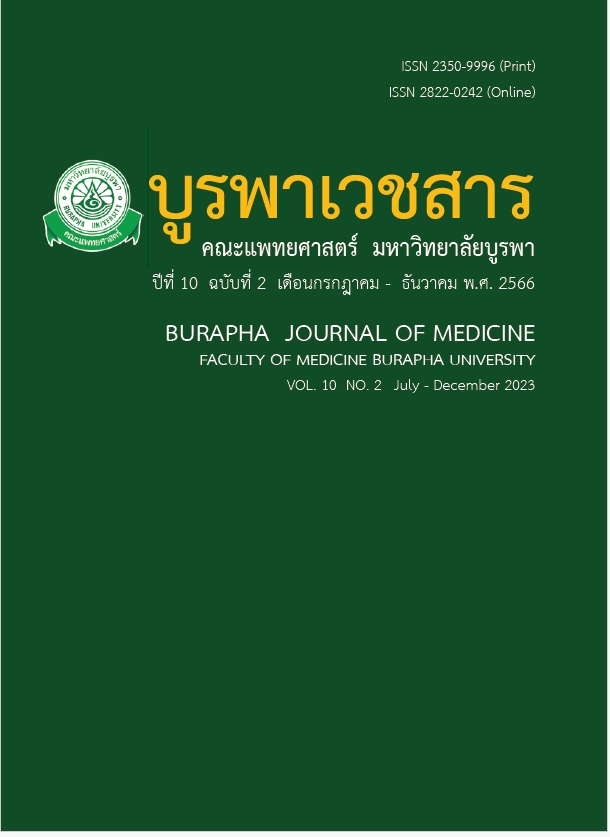Mortality rate in pediatric drowning at Burapha University Hospital
Main Article Content
Abstract
Context: One of the main causes of death among children is drowning. Studying the mortalityrelated factors in pediatric drowning incidents is crucial.
Objectives: To determine the significant factors of drowning-related cases and mortalities in children receiving treatment at Burapha University Hospital.
Methods: A retrospective descriptive study was conducted on pediatric patients (under the age of 15) receiving care for drowning or drowning-related events at Burapha University Hospital between January 1, 2013, and December 31, 2022. Statistics were analyzed using baseline data, drowning-related information, treatments and outcomes.
Results: A total of 49 pediatric patients with a mean age of 5.22 ± 3.10 years were included in this study. The majority of them (85.71%) drowned in seawater and were male (57.14%). The peak drowning period was from 4 to 8 pm (40.82%). October, December and January saw the highest rates of drowning (24.49%, 22.45% and 10.20%, respectively). The median time of submersion was 1 minute [0.5–2], and the median length of disappearance (in cases without witnesses) was 5 minutes [2–30]. Cardiopulmonary resuscitation and tracheal intubation were needed for 26.53% and 22.45% of the patients, respectively. For cases in freshwater, the serum sodium level was 134.75 ± 4.03 mEq/L, while in the seawater group it was 144.18 ± 3.01 mEq/L. Of the 49 patients, four drowning deaths occurred (8.16%). Statistically significant factors of the
four deaths included a greater-than-10-minute, unwitnessed disappearance time (p=0.008), a cardiopulmonary resuscitation time longer than 25 minutes (p < 0.001), fixed pupils (p<0.001), a Glasgow Coma scale less than 5 (p < 0.001) as well as the salinity of the body of water (freshwater (p = 0.033) versus seawater).
Conclusions: The disappearance time, length of cardiopulmonary resuscitation, fixed pupils, Glasgow Coma scale, and salinity of the body of water all had an impact on the mortality rate of the drowning victims (8.16%).
Article Details

This work is licensed under a Creative Commons Attribution-NonCommercial-NoDerivatives 4.0 International License.
References
World Health Organization. The global report on drowning [Internet]. 2014 [accessed Oct 1, 2022] Available from: https://apps.who.int/iris/bitstream/handle/10665/143893/9789241564786_eng.pdf
World Health Organization [Internet]. 2021 [accessed Oct 1, 2022]. Available from: https://www.who.int/news-room/fact-sheets/detail/drowning.
กองป้องกันการบาดเจ็บ กรมควบคุมโรค กระทรวงสาธารณสุข. สถานการณ์การตกน้ำ จมน้ำ ในประเทศไทย ปี พ.ศ. 2558–2562 (Situation Analysis of Drowning in Thailand 2015–2019). นนทบุรี, ประเทศไทย [Internet]. 2022 [accessed Oct 1, 2022]. Available from: https://ddc.moph.go.th/uploads/publish/1343620221109042458.pdf
Quan L, Bierens JJ., Lis R, Rowhani-Rahbar A, Morley P, Perkins GD. Predicting outcome of drowning at the scene: A systematic review and meta-analyses. Resuscitation. 2016; 104: 63–75.
Denny SA, Quan L, Gilchrist J, McCallin T, Shenoi R, Yusuf S, et al. Prevention of Drowning. Pediatrics. 2021; 148: e2021052227.
Orlowski JP. Prognostic factors in pediatric cases of drowning and near-drowning. JACEP. 1979; 8: 176–9.
Mosayebi Z, Movahedian AH, Mousavi GA. Drowning in children in Iran: Outcomes and prognostic factors. Med J Malaysia. 2011; 66: 187–90.
Torimitsu S, Yajima D, Inokuchi G, Makino Y, Motomura A, Chiba F, et al. Electrolyte analysis of pleural effusion for discrimination between seawater and freshwater drowning in decomposed bodies. J Forensic Leg Med. 2022: 90; 102389.
Garland J, Philcox W, Kesha K, McCarthy S, Lam LCS, Palmiere C, et al. Elevated Cerebrospinal Fluid Sodium and Chloride Levels in a Saltwater Drowning Death. Am J Forensic Med Pathol. 2019; 40: 258–61.
Susiva C, Boonrong T. Near-drowning in Pediatric Respiratory Intensive Care Unit, Siriraj Hospital. J Med Assoc Thai. 2005; 88 Suppl: S44–7.
Ruthaiwat J. Near drowning in pediatric department, Surin hospital in 2006-2008. MJSSBH. 2009; 24: 315–26.
Wiriyakunnan P, Wijakprasert P. Mortality rate of childhood drowning. Thai J Pediatr. 2022; 61: 49–56.
Prameprart M, Lim A, Tongkumchum P. Modeling unintentional drowning mortality rates in Thailand, 2000-2009. Asia Pac J Public Health. 2015; 27: NP2471–9.
Mott TF, Latimer KM. Prevention and Treatment of Drowning. Am Fam Physician. 2016; 93: 576–82.
Reizine F, Delbove A, Dos Santos A., Bodenes L, Bouju P, Fillatre P, et al. Clinical spectrum and risk factors for mortality among seawater and freshwater critically ill drowning patients: a French multicenter study. Crit Care. 2021; 25: 372.

